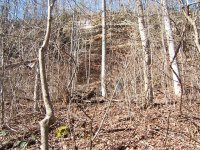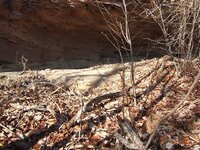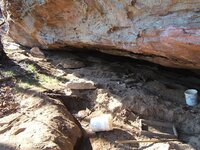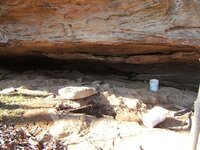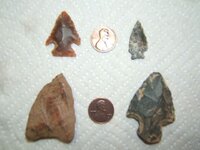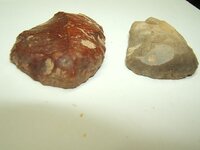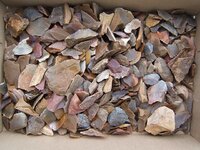Navigation
Install the app
How to install the app on iOS
Follow along with the video below to see how to install our site as a web app on your home screen.
Note: This feature may not be available in some browsers.
More options
You are using an out of date browser. It may not display this or other websites correctly.
You should upgrade or use an alternative browser.
You should upgrade or use an alternative browser.
Weekend rock shelter finds with pics of the shelter
- Thread starter 1320
- Start date
reuellis
Sr. Member
awesome! thanks for the pics.
1320
Silver Member
- Thread starter
- #5
Disclaimer: The soda cans were left by someone else...lol. I will remove them next trip though. If you look close, you'll see previous holes and sift piles in and around the shelter. The land owner told me that he'd be surprised if I found anything because he "dug it pretty good". Well, he did dig the first 12 inches pretty good...lol. I have shown him all the finds and fortunate for me, he does not have artifact envy. He celebrates with me and appreciates the passion for digging. This guy is on my Christmas list...lol.
redbeardrelics
Hero Member
- Jan 3, 2014
- 891
- 1,019
- Detector(s) used
- Garrett GTI 2500, (Ace 250 spare)
- Primary Interest:
- Other
That is so cool. It looks to me like there may be a lot of digging yet to go there, any idea yet of how deep the cultural deposits may go? I really like the smaller notched point from this dig, and the two you showed from the prior dig. Would you consider them mid or early archaic points, and do you think that shelter is pretty well stratified, or somehow has components mixed? That sure does look like a lot of flint, you just know some of it can be pieced back together, but with the amount it looks like you will end up with, it will be a lengthy process. Thanks for the photos and dig on!
1320
Silver Member
- Thread starter
- #8
That is so cool. It looks to me like there may be a lot of digging yet to go there, any idea yet of how deep the cultural deposits may go? I really like the smaller notched point from this dig, and the two you showed from the prior dig. Would you consider them mid or early archaic points, and do you think that shelter is pretty well stratified, or somehow has components mixed? That sure does look like a lot of flint, you just know some of it can be pieced back together, but with the amount it looks like you will end up with, it will be a lengthy process. Thanks for the photos and dig on!
Indeed, it will take at least a year to dig it complete, perhaps longer. We (my brother and I) haven't figured out much on this one regarding depth and stratification. We'll find the depth eventually, we like to take out one layer at a time and right now we are mainly focused on removing the prior sift piles. We have hit some undug strata at the 18 inch mark but we stopped there. We try to "level" the entire shelter before we get real crazy. This shelter (like all) was dug sporadically and randomly and I'm not sure a sifter was used. The components are pretty junked up, like someone used a giant blender in it...lol. So, we are finding Archaic on top of Woodland and vice versa. The Pine Tree and Kirk (first post) are generally considered early Archaic but they could be well into the mid Archaic. The abundance of uniface scrapers lends itself to the early period.
The box of flint in this post was a sampling of yesterday's dig. We removed one piece of flint from each sifter load and set it aside! We're tossing off to the side probably 50 pieces (50:1 ratio). It is incredible. We have been into a lot of shelters over the years and nothing rivals this one in terms of flint volume. There is a software package available that can be used to scan images of the flint, it will number each piece then provide the matches but it's way too costly and the time required would take years to catalog each piece but yes, it can be done. Since we are stockpiling the flint in this one, we may stumble on a match, especially with the Jasper...it's easy to match back up.
1320
Silver Member
- Thread starter
- #9
your stuff looks pretty "recent"....suggests to me you need to go DEEPER...
Agree. Yesterday's artifacts have a Woodland look. We did find a Pine Tree and a Kirk on our first dig, the previous digging has scrambled the matrix pretty good but we'll get it fixed and dive deep...that's our speciality. It's not uncommon for my brother and I to dig 5 to 6 feet!
bone2stone
Full Member
- Oct 9, 2012
- 156
- 111
- Primary Interest:
- All Treasure Hunting
Congratulations on having an area where you get the satisfaction of digging. 
How far out from the shelter has digging been done, because the entire area is subject to have good potential.
The stone at the approach, may have fallen within historical times. If so there too is potential.
Down side of digging under enormous stones is the subsurface is compacted to a point of "like concrete".
The indigenous peoples lived outside the shelter most of the time, and used the shelters overhanging stone as needed depending on the weather.
Some of the stone shelters approaches, here in Texas, are very deep.
Occupied over periods of thousands of years.
Jess B.
How far out from the shelter has digging been done, because the entire area is subject to have good potential.
The stone at the approach, may have fallen within historical times. If so there too is potential.
Down side of digging under enormous stones is the subsurface is compacted to a point of "like concrete".
The indigenous peoples lived outside the shelter most of the time, and used the shelters overhanging stone as needed depending on the weather.
Some of the stone shelters approaches, here in Texas, are very deep.
Occupied over periods of thousands of years.
Jess B.
Last edited:
NCPeaches
Silver Member
That is so cool! I've never dug a shelter and wouldn't know one if I saw it, wish I did though. I'm gonna have to research it.
Bum Luck
Silver Member
- May 24, 2008
- 3,482
- 1,282
- Detector(s) used
- Teknetics T2SE, GARRETT GTI 2500, Garrett Infinium
- Primary Interest:
- All Treasure Hunting
I got a theory that the "shelter" was augmented by the addition of tree trunks and so forth to provide the other wall we don't see any more. It kept them warmer and more secure. It would have made a decent dwelling.
- Jun 8, 2006
- 6,139
- 8,527
- Detector(s) used
- Whites, Minelab, Tesoro, and custom machines
- Primary Interest:
- Metal Detecting
The top is probably just jumbled up. Just the way it looks tells me you're going to have to go deep. It was probably in use before the Archaic. Tony
Last edited:
- Jun 8, 2006
- 6,139
- 8,527
- Detector(s) used
- Whites, Minelab, Tesoro, and custom machines
- Primary Interest:
- Metal Detecting
Don't forget to go up on top of the ledge and scratch around some. On a nice day that would be a great place to sit, work tools and watch out! Tony
- Jan 27, 2009
- 18,725
- 11,731
- 🥇 Banner finds
- 1
- Detector(s) used
- Tesoro Conquistador freq shift
Fisher F75
Garrett AT-Pro
Garet carrot
Neodymium magnets
5' Probe
- Primary Interest:
- All Treasure Hunting
1320 I know you are a pro on shelters but I have found outside of some of them especially if there are additional large boulders that they sometimes hold more than the shelter . Do you ever venture outside the overhang? It all depends I guess if it was just a seasonal nut hunting shelter or a lower elevation one used year round. I know old topic. Congratulation on your digs once again.Congratulations on having an area where you get the satisfaction of digging.
How far out from the shelter has digging been done, because the entire area is subject to have good potential.
The stone at the approach, may have fallen within historical times. If so there too is potential.
Down side of digging under enormous stones is the subsurface is compacted to a point of "like concrete".
The indigenous peoples lived outside the shelter most of the time, and used the shelters overhanging stone as needed depending on the weather.
Some of the stone shelters approaches, here in Texas, are very deep.
Occupied over periods of thousands of years.
Jess B.
HH
TnMtns
1320
Silver Member
- Thread starter
- #20
1320 I know you are a pro on shelters but I have found outside of some of them especially if there are additional large boulders that they sometimes hold more than the shelter . Do you ever venture outside the overhang? It all depends I guess if it was just a seasonal nut hunting shelter or a lower elevation one used year round. I know old topic. Congratulation on your digs once again.
HH
TnMtns
This one does have some large boulders out front and that's were we started the dig. We call them "knapping rocks" or "knapping stations". We're just about done with the digging around them. Most of the shelters around here have mature and immature trees just past the drip line which makes for difficult digging but I agree, sometimes there is much more out front. Next dig, I'll snap some pics of the front and post them up. Old topic but still a great lesson for those that haven't dug much or who have otherwise disregarded the front of a shelter.
Top Member Reactions
-
 1981
1981 -
 1000
1000 -
 981
981 -
 972
972 -
 952
952 -
 941
941 -
 888
888 -
 827
827 -
 737
737 -
 633
633 -
 394
394 -
 389
389 -
 369
369 -
 349
349 -
 345
345 -
E
343
-
 325
325 -
 299
299 -
 289
289 -
 287
287
Users who are viewing this thread
Total: 2 (members: 0, guests: 2)


